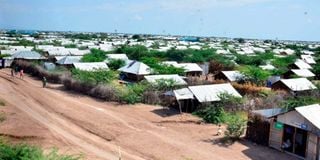Kenya to close Kakuma, Dadaab refugee camps by June 2022

Kakuma Refugee Camp, located along Kenya's border with Somalia, as pictured on June 10, 2018.
Kenya has rescheduled its planned closure of refugee camps to June next year. This decision was arrived at on Thursday following discussions with the United Nations High Commissioner for Refugees (UNHCR) to stagger the shut-down.
As such, Kakuma and Dadaab Refugee camps will be closed down by June next year, to allow refugees to leave gradually rather than in masses.
The decision arose from last-minute lobbying by the UNHCR boss Fillipo Grandi who held discussions with Interior Cabinet Secretary Fred Matiang’i and Foreign Affairs counterpart Raychelle Omamo.
Under the new arrangement, at least 15,000 refugees will be let go every month; either to return to their homelands or be resettled elsewhere.
Interior Principal Secretary Karanja Kibicho said the decision is the last considerate move by Kenya to stay within international law as well as protect its national security interests.
“We have been sheltering refugees for over 30 years, and our capacity to host them longer under minimum standards of humanitarian action has been overstretched,” Dr Kibicho said.
“The decision to close Dadaab and Kakuma camps by June 30, 2022 is in our country’s public interest,” he added.
It means Nairobi has, for the fifth time, delayed its plan to close the camps. In 2013, Kenya, Somalia and the UNHCR had reached a tripartite agreement to gradually close Dadaab.
The agreement expired with just a small fraction of refugees accepting to return home voluntarily. Further plans have been challenged in court. On Tuesday, the High Court also suspended Nairobi’s plan. But this came as discussions went on for a staggered closure. The US government also pleaded for delay, arguing Kenya could violate its obligations if it closed the camps abruptly.
The two refugee camps in Turkana and Garissa counties respectively have been in existence since early 1990s when Somalia fell among warlords, and neighbouring countries Sudan, Rwanda and Burundi were in their conflicts.
Dadaab predominantly has Somali refugees and hosts about 220,000 refugees. Kakuma hosts about 16 0,000 mainly from South Sudan. The government has often accused some refugees of harbouring terrorists, claims UNHCR has fought.





